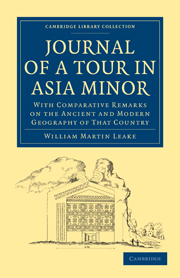 Journal of a Tour in Asia Minor
Journal of a Tour in Asia Minor Published online by Cambridge University Press: 13 June 2011
Before we pursue our route beyond the capital of the Greek province Lycaonia and of the Turkish kingdom Karamán, it may be right to offer a few remarks upon the general geography of this part of the peninsula, and upon the situation of some of the opulent and celebrated cities which anciently adorned it.
From the sources of the Sangarius and Halys on the north and east, to the great summits of Mount Taurus on the south-west and south, there is an extent of country nearly 250 miles long and 150 broad, in which the waters have no communication with the sea. Its southern part consists of fertile valleys or of extensive plains intersected by a few ranges of hills, and it is bounded to the southward by the great ridges of Mount Taurus, from whence are poured forth numerous streams, which, after fertilizing the valleys, collect their superabundant waters in a chain of lakes, extending from the neighbourhood of Synnada in Phrygia through the whole of Lycaonia to the extremity of the Tyanitis in Cappadocia. In the rainy season these lakes overflow the lower part of the plains, and would often form one entire inundation 200 miles in length, were it not for some ridges which traverse the plains and separate them into several basins. By the structure of the hills, and the consequent course of the waters, these basins form themselves into three principal recipients, having no communication with one another, unless it be in very extraordinary seasons.
To save this book to your Kindle, first ensure [email protected] is added to your Approved Personal Document E-mail List under your Personal Document Settings on the Manage Your Content and Devices page of your Amazon account. Then enter the ‘name’ part of your Kindle email address below. Find out more about saving to your Kindle.
Note you can select to save to either the @free.kindle.com or @kindle.com variations. ‘@free.kindle.com’ emails are free but can only be saved to your device when it is connected to wi-fi. ‘@kindle.com’ emails can be delivered even when you are not connected to wi-fi, but note that service fees apply.
Find out more about the Kindle Personal Document Service.
To save content items to your account, please confirm that you agree to abide by our usage policies. If this is the first time you use this feature, you will be asked to authorise Cambridge Core to connect with your account. Find out more about saving content to Dropbox.
To save content items to your account, please confirm that you agree to abide by our usage policies. If this is the first time you use this feature, you will be asked to authorise Cambridge Core to connect with your account. Find out more about saving content to Google Drive.